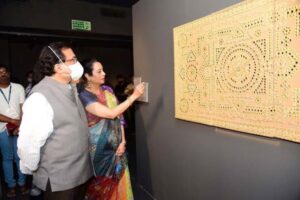Team L&M
As a part of Azadi ka Amrit Mahotsav, the Ministry of Culture has organised an exhibition titled Sutr Santati at National Museum, New Delhi. Organised in association with the National Museum and the Abheraj Baldota Foundation, Sutr Santati has brought together the diverse textile traditions of country under one roof. The title Sutr Santati , which literally means the continuity of yarn, is a metaphor for the ongoing dialogues in Indian culture and society, which shape its evolution, bridging the past with the future.
Inaugurated by Mr Govind Mohan, Secretary, Ministry of Culture, Government of India, the exhibition has on display more than 100 textiles by 75 prominent artisans, craftspeople, designers, and artists, and is curated by Lavina Baldota.

The key feature of this exhibition is craftsmanship and ecological preservation. On view are textiles created with processes of hand weaving, embroidery, resist-dyeing, printing, painting and appliqué, among other forms of yarn and fabric manipulation. The fibres employed in these commissions range from local varieties such as Kandu and Kala cotton, mulberry and wild silks, camel and sheep wool, goat and yak hair. The exhibition’s curatorial vision seeks to promote the ideals of organic and slow consumerism in defining a nation such as India’s self worth, and the inherent collective, collaborative efforts which are required to push towards such goals..
Some of the prominent names participating are Waseem (kalamkari painted with ari, kani and handwoven pashmina jamavar); Vijay Guled (ilkal), Shunya (batik – Tagore poetry), Abu Sandeep, Asif Sheikh (CDS), Charlie Mathleena, Darshan Shah (Weaver’s Studio), Jesmina Zeliang (Heirloom Naga), Pushyamitra Joshi (Eco Fab), Sabiha Dohadwala and Sukanya Garg.
The exhibition will continue till September 20